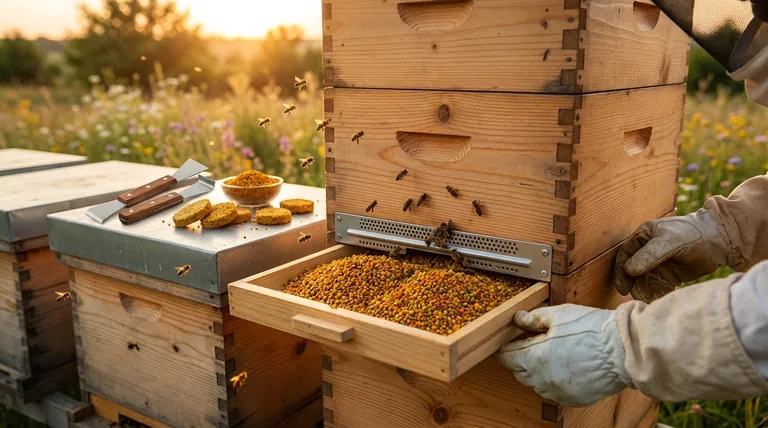To put it simply, beekeepers collect pollen using traps to create a high-protein food reserve for their colonies. This stored pollen is essential for feeding bees and stimulating brood rearing during critical periods, such as early spring, when natural pollen sources are scarce.
The core strategy is proactive resource management. A pollen trap allows a beekeeper to harvest a surplus of protein during times of abundance and redeploy it as supplemental feed to ensure the colony's health and growth when natural forage is limited.

The Strategic Value of a Pollen Reserve
A honey bee colony's ability to grow and thrive is directly tied to its protein intake, and pollen is its sole natural source of protein. A readily available supply is the engine of colony development.
Fueling Early Season Growth
After the long winter, a queen's primary imperative is to begin laying eggs to build the colony's population. This new brood requires massive amounts of protein to develop, often before local flowers have started to bloom.
Pollen collected from the previous season provides the perfect nutritional jump-start.
Creating Supplemental Feed
Beekeepers rarely feed pure pollen back to the bees. Instead, they mix the collected pollen with extenders like soybean flour or brewer's yeast.
This mixture is formed into pollen patties, which are placed directly on top of the frames inside the hive for easy consumption by the nurse bees.
Supporting Queen Rearing
Raising strong, healthy queens requires an optimal and consistent diet. A lack of high-quality protein can result in poorly developed queens.
By using stored pollen, beekeepers can ensure their queen-rearing operations are never compromised by a temporary shortage of natural forage.
How a Pollen Trap Works
The trap itself is a simple but clever mechanical device designed to harvest pollen without crippling the colony's own collection efforts.
The Core Mechanism
A pollen trap consists of a screen, mesh, or plate with small holes that is placed over the hive entrance. Returning forager bees are forced to squeeze through these openings to re-enter the colony.
Dislodging the Pollen Pellets
As a bee pushes through a hole, the edges scrape against its hind legs, knocking off some of the compacted pollen pellets stored in its "pollen baskets" (corbiculae).
These dislodged pellets fall through another screen and into a collection tray or drawer below, which the beekeeper can empty regularly.
A Balanced Harvest
A well-designed trap is not meant to collect all incoming pollen, as this would starve the hive. Traps are calibrated to knock off a certain percentage of the pollen pellets—typically 30% to 70%.
This ensures the beekeeper gets a harvest while still allowing enough pollen to enter the hive to meet the colony's immediate needs.
Understanding the Trade-offs
While effective, using a pollen trap is an intervention that comes with considerations that every beekeeper must weigh.
Potential Pest Attraction
The collected pollen in the tray can sometimes act as an attractant for other pests, such as hive beetles. Proper trap maintenance and regular collection are crucial to mitigate this risk.
Restricting Hive Traffic
The trap partially obstructs the hive entrance. While bees quickly adapt, it can temporarily slow the flow of traffic in and out of the colony, which is a minor stressor.
Risk of Over-Harvesting
It is critical to use the trap only during strong pollen flows and for limited periods. Leaving a trap on for too long or during a pollen shortage can deprive the colony of the protein it needs for its own brood.
Making the Right Choice for Your Goal
Deciding to use a pollen trap depends entirely on your specific beekeeping objectives.
- If your primary focus is rapid spring buildup: Use a trap during the peak of the main summer flow to create pollen patties for feeding in late winter or early spring.
- If your primary focus is queen or nuc production: Collecting pollen ensures you have a consistent protein supply to fuel the creation of new, healthy colonies.
- If your primary focus is colony self-sufficiency: Avoid using a trap and allow the bees to manage their own pollen stores without intervention.
Ultimately, collecting pollen is a powerful tool for giving your colonies the nutritional support they need, precisely when they need it most.
Summary Table:
| Key Purpose | How It Works | Ideal For |
|---|---|---|
| Create protein reserves | Harvests surplus pollen during abundance | Supporting early spring growth |
| Stimulate brood rearing | Mixes with extenders for pollen patties | Queen rearing and nuc production |
| Ensure colony health | Traps collect 30-70% of incoming pollen | Beekeepers focused on rapid buildup |
Ready to optimize your apiary's protein management? At HONESTBEE, we supply commercial apiaries and beekeeping equipment distributors with high-quality pollen traps and essential beekeeping supplies. Our wholesale-focused operations ensure you get durable, effective equipment to support colony health and maximize your productivity. Contact us today to discuss your needs and discover how our solutions can help you build stronger, more productive colonies.
Visual Guide

Related Products
- Professional Dual-End Stainless Steel Hive Tool for Beekeeping
- HONESTBEE Professional Long Handled Hive Tool with Precision Cutting Blade
- Multi-Function Plier-Style Frame Grip Hive Tool
- HONESTBEE Professional Multi-Functional Hive Tool with Ergonomic Wood Handle
- Professional Stainless Steel Pry-Bar Hive Tool
People Also Ask
- What is a hive tool used for in beekeeping? Your Essential Guide to Hive Management
- Why is proper beekeeping equipment important? Essential for Safety and Hive Health
- What are the normal functions of a hive tool? The Essential Multi-Tool for Every Beekeeper
- What should beginners consider when purchasing beekeeping equipment? A Guide to Essential Starter Gear
- How should beekeepers handle bees when using a hive tool? Master Calm, Deliberate Techniques



















